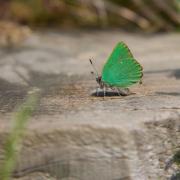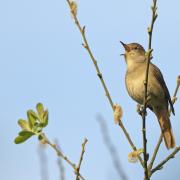There are all sorts of myths and misconceptions about the mysterious hare. Jill Mason looks at their fecundity, folklore and fighting habits, and finds there’s still much we have to learn
There is something special about a hare. Many people can’t tell a hare from a rabbit, but those who can make the distinction, often become charmed by this weird animal whose behaviour can defy all logic.

Mad as a March hare
The sight of boxing hares is often misunderstood, with many people assuming they are witnessing two males sparring. In reality it is a female hare (a doe) fending off the unwanted attentions of a male with whom she is unwilling to mate. The other common misconception is that hares go ‘mad’ and caper about wildly during a full moon, whereas it is likely that the full moon has simply made them visible to a bystander: they are out in the fields every night!
In Britain, Brown hare courtship begins in January and continues until August or even later. Breeding occurs almost continuously in mild winters and a few leverets may be born as early as January or February. Mountain hares don’t start reproducing until March and finish in August or early September.
Bucks are very promiscuous and many at a time may be attracted to a female prior to her being properly in season. A male will stay close to a doe, guarding her, until after mating has taken place. Several males will be drawn to the vicinity of the doe from different directions and there are many scuffles as the males are intent on trying their luck and keep harassing her. Fighting, boxing, scratching and biting takes place and the fur often flies but usually it is the doe who is the aggressor as she tries to fend off their unwanted attentions. Although they normally live a solitary existence, the bucks themselves have a loose social hierarchy and they are aware of where they stand in the pecking order, so that fighting among themselves is kept to a minimum.
A doe is only on heat for a few hours. There is an old saying that the pregnancy of a mare and a hare added together last a year, but a shortage of facts regarding the breeding of hares means there is a difference of opinion as to how long the pregnancy lasts. Hares cannot be successfully domesticated and it is very difficult to observe at close quarters a nocturnal animal in the wild. As a result, the precise gestation period of hares is not known. It could be as little as 30 days but the general opinion is that it is about 42 for Brown hares. It is thought that gestation lasts an extra week for Mountain and Irish hares.

Does are usually mated again soon after giving birth and unless she is in peak condition, it is not uncommon for the foetuses to be reabsorbed.
Researchers have discovered that it is possible for a Brown hare doe to conceive again while already pregnant. This is known as superfoetation and both the pregnancies apparently continue without either interfering with the other.
Litters may vary in size from one to seven. Usually between two and four young are born, depending on the time of year. There may be three or four litters annually.
At the height of the breeding season in spring, researchers have estimated that 100% of does over a year old are pregnant. They do not usually breed in the year in which they were born.
It was recorded in 1840 that an experiment by the Reverend B. Daniel had been conducted into the fecundity of Brown hares. A brace of hares, the doe pregnant at the time, had been released into the protection of a large walled garden, provided with ‘proper plants for their sustenance’ and left unhindered to their own devices. After a twelve-month period the garden was searched and it was found that the original pair had produced a total of 57 offspring! The frequency of litters and the number in them can be greatly affected by the weather. December is probably the least likely month in which to find new born Brown hare leverets.
Mountain hare breeding
The lengthening hours of daylight soon after the winter equinox trigger off reproduction in the Scottish Mountain hare. The does may be mated as early as January and the gestation period is about 50 days. The first of the two or three litters born each year arrive towards the end of February or early in March but rarely survive because the weather is still bad this early in the year and the quality of food available is very poor. Harsh weather and predation by foxes and large birds of prey such as golden eagles and goshawks can have a significant impact on the survival of young Mountain hares.
There is debate over the subject of interbreeding between the lowland Brown hare, the Irish hare and the upland Mountain hare. Certainly, their ranges overlap in many areas and some Victorian naturalists believed that hybrids existed. This is generally considered to be possible, but rare.

Raising offspring
Male hares play no part in raising their offspring.
Leverets are born on top of the ground and no nest is made. Despite their inherent wariness, it is not unusual to find that Brown hares give birth to their young in close proximity to humans, even in the flower borders or vegetable beds of country cottage gardens.
The leverets are born fully furred, have their eyes open and within a short time become active and able to run. At first the colour of a leveret’s eyes is dark blue, almost black, but they soon change to a rich golden colour.
After a few hours the doe spreads her litter out in different places to lessen the likelihood of predators finding and killing all of them. This she probably does by carrying them in her mouth. The odd clump of rough grass in pasture fields may be the only available cover. It is rare for leverets to be hidden in hedges as this is the haunt of stoats and foxes, two of their worst enemies.
At this early stage in their lives, leverets are extremely vulnerable, relying on keeping
dividually. The general consensus is that she calls them to her, as there have been many sightings of more than one suckling at a time.
It has been observed that, when approaching or leaving her young, she goes through the same antics to cover up her scent as when she goes to her form: back-tracking, leaping etc. The rest of the time she keeps her distance from the leverets but stays in the vicinity and will fight for their safety should they be at risk, even attacking cows or sheep if they approach too close.
Leverets begin to eat grass after 10 to 14 days and are fully weaned at about 4–6 weeks old, from which time they have to fend for themselves. Weaning is often brought about by the imminent birth of another litter. Leverets sometimes gather together in groups when they are a few weeks old.
Young hares are mature at about six months of age but do not normally breed in the year in which they were born.
still and camouflage for their sole protection. The doe only visits once a day to suckle them for a short period which she does in a sitting position. Opinion differs whether the leverets gather together to suckle at the place where they were born, or whether the doe calls them up, or whether some does visit each one in

A celebration of the hare
The hare is and always will be a much-loved species associated with folklore and springtime. Their number have seen decline, but with better understanding about their behaviour, habitat requirements and breeding, we hope to see their numbers increase. Let us hope that hares will always be part of our countryside, as it would certainly be a much poorer place without this curious creature.
You can find out more about this most fascinating of species in The Hare by Jill Mason, published by Merlin Unwin Books (£20 colour hardback). merlinunwin.co.uk

Information
Some differences between hares and rabbits
• Rabbits are smaller, have shorter ears, closer coats
• Rabbits are more grey than hares
• Rabbits are gregarious while hares are solitary
• Rabbits prefer the margins of fields, hares the open ground
• Rabbits inhabit burrows, hares live above ground
• Rabbits are born naked and blind, hares are born fully furred and with their eyes open
The Brown hare does best where there is a mixture of crops being grown. Unlike the less demanding Mountain and Irish hares, the Brown hare is a fussy feeder and needs variety.
A hare’s need for solitude
With the curious exception of airports, hares do not generally tolerate disturbance. They do not adapt to urbanisation and are rarely found in the vicinity of regularly-used public footpaths.




























